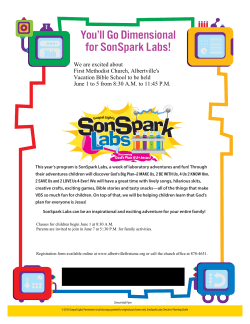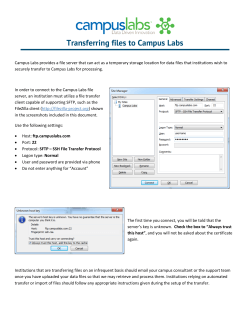
Call for Papers - ieee globecom 2015
IEEE GLOBECOM 2015 7th Int. Workshop on Heterogeneous and Small Cell Networks (HetSNets) Workshop Chairs Ming Ding National ICT Australia (NICTA), Australia David López-Pérez Bell Labs, Alcatel-Lucent, Ireland Ismail Guvenc Florida International University, USA Sayandev Mukherjee DOCOMO Innovations Inc., USA Luca Rose Huawei Technologies, France Steering Committee Anthony C. K. Soong Huawei Technologies, USA Anna Zakrzewska Bell Labs, Alcatel-Lucent, Ireland Guoqiang Mao The University of Technology Sydney, Australia Tech. Program Comm. Huseyin Arslan, Istanbul Medipol University, Turkey Tuncer Baykas, Istanbul Medipol University, Turkey Xiaoli Chu, University of Sheffield, UK Holger Claussen, Bell Labs, Alcatel-Lucent, Ireland Bruno Clerckx, Samsung Advanced Institute of Technology, S. Korea Deniz Gündüz, Imperial Colleague, UK Guang Han, Motorola Inc., USA Lester Ho, Bell Labs, Alcatel-Lucent, Ireland Tingfang Ji, Qualcomm, USA Satoshi Konishi, KDDI, Japan Stepan Kucera, Bell Labs, Alcatel-Lucent, Ireland Lars Lindlom, Ericsson, Sweden Constantinos Papadias, AIT, Greece Petar Popovski, Aalborg University, Denmark Venkatesh Ramaswamy, Airvana Inc., USA Hyundong Shin, Kyung-Hee University, Korea Rahul Vaze, TIFR, India Akira Yamada, Research Labs, NTT DOCOMO, JP Sheng Yang, Supélec, France Jeff Andrews, University of Texas at Austin, USA Sergio Barbarossa, University of Rome "La Sapienza", Italy Runhua Chen, Texas Instruments, USA Anthony Ekpenyong, Texas Instruments, USA Lorenza Giupponi, CTTC, Spain Robert Love, Motorola, USA Ruben Merz, Deutsche Telekom Lab., Germany Nobuhiko Miki, Kagawa University, Takamatsu, JP Juan Montojo, Qualcomm, USA Atta Quddus, UNIS, UK Alberto Rabbachin, MIT, USA Rouzbeh Razavi, Bell Labs, Alcatel-Lucent, Ireland Iana Siomina, Ericsson, Sweden Joseph Vidal, UPC, Spain Jie Zhang, University of Sheffield, UK Yingang Du, Huawei, China Ana-Maria Galindo, Orange, France Mehdi Bennis, Oulu University, Finland Guillaume de la Roche, Mindspeed Tech., France Lorenzo Galati, Azcom Technologies, Italy Raymond Kwan, Cisco, UK Important Dates Paper Submission: July 1st 2015 Acceptance Notification: Sep. 1st 2015 Camera-Ready: Oct. 1st 2015 Workshop: Dec. 10th 2015 Call for Papers In recent years, with the advent of more easy-to-use and powerful mobile user equipment (UEs) such as smartphones and tablets, and with the development of more appealing Internet applications, mobile data traffic has been increasing in an exponential manner. This trend is expected to continue during the next decade. In this context, heterogeneous and small cell networks (HetSNets), which are characterized by a large number of network nodes with different transmit power levels and radio frequency coverage areas, including macrocells, remote radio heads, microcells, picocells, femtocells and relay nodes, have attracted much attention in the wireless industry and research community. They have also gained the attention of standards bodies such as the 3rd Generation Partnership Project (3GPP), overseeing the development of the LTE/LTE-Advanced standards, and the Institute of Electrical and Electronics Engineers (IEEE), overseeing the development of Mobile Worldwide Interoperability for Microwave Access (WiMAX). HetSNets have also been the major focus in the research and development efforts for emerging 5G wireless networks. However, the impending worldwide deployments of HetSNets bring about not only opportunities but also challenges. Despite many accomplishments in HetSNets development and deployment in the last few years, many technical challenges to efficient rollouts of HetSNets remain. Among these are the co-existence and inter-working of mixed-type neighbouring and/or overlapping cells, inter-cell interference and mobility management, fronthaul and backhaul provisioning, energy saving issues, self-organization, and capacity enhancements through coordinated multiple input multiple output (MIMO) operations. These challenges need to be addressed in order for HetSNets to deliver their promise. This calls for a thorough reappraisal of contemporary wireless network technologies, such as network architecture, protocol designs, spectrum allocation strategies, radio access management mechanisms, etc. In order to do so, those in the wireless industry, academia and even endusers need to better understand the technical details and the full potential of HetSNets. This workshop will bring together academic and industrial researchers to identify and discuss technical challenges and recent results related to 5G HetSNets. Topics of interest include, but are not limited to the following: New front- and back-haul architectures to facilitate HetSNets operations (cloud radio access network (RAN), self-backhauled small cells, user and control plane split, multi-flow, etc.) Self-organizing HetSNets and issues in self-configuration, self-optimization and self-healing Small cells network deployment tools (e.g., hotspot identification, metrocell placement tools, network optimization engines) Improved mobility management in HetSNets and small-cell discovery mechanisms Radio resource management (RRM) techniques for HetSNets (network synchronization, cell range expansion, loading balancing, dynamic TDD transmissions, cognitive schemes, etc.) Inter-cell interference coordination (ICIC) in HetSNets (cell clustering, cell on/off techniques, carrier based ICIC, time based ICIC, power based ICIC, etc.) Use of higher frequency bands, radio propagation models and measurement campaigns for small cell networks Coordinated multi-point transmission (CoMP) techniques in HetSNets (coordinated beamforming, network MIMO, etc.) Dynamic downlink/uplink transmissions and full duplexing transmissions in HetSNets Inter-node carrier aggregation and dual connectivity in HetSNets Advanced receivers and interference cancellation in HetSNets Concepts for energy efficiency enhancements in HetSNets and dormant mode operation of small cells Semi-static or dynamic switch between the macrocell and small cell tiers at UEs Inter-working and coexistence of various radio access technologies in HetSNets (the coexistence of Wi-Fi and LTE, i.e., Licensed Assisted Access LTE-Unlicensed, etc.) File caching/storage strategies in HetSNets to facilitate efficient content distribution Feature keynotes will be addressed by Dr. Rajesh, Pankaj (Qualcomm Inc., CA), Prof. Andreas Molisch (USC, CA), and Prof. Vincent Lau (HKUST, Hong Kong). The workshop accepts only novel, previously unpublished papers. Prospective authors are encouraged to submit a 5-page standard IEEE conference style paper to this workshop (including all text, figures, and references) through EDAS submission system (http://www.edas.info). One additional page may be allowed but with extra publication fee. Accepted papers must be presented at the workshop, and the presenter must be registered for the workshop. All papers selected for publication will be included in the IEEE Globecom proceedings and IEEE digital library. Website: https://sites.google.com/site/hetsnets2015/
© Copyright 2025










